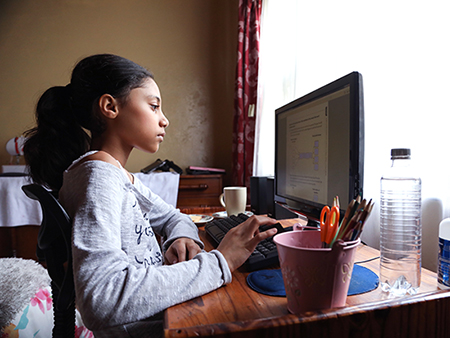 Children’s eyesight may be impacted by virtual learning during COVID-19, but UAB experts share tips on how to ensure optimal eye health for kids.As schools choose virtual learning and device-based instruction to educate children during the COVID-19 pandemic, a child’s eyes are an important consideration.
Children’s eyesight may be impacted by virtual learning during COVID-19, but UAB experts share tips on how to ensure optimal eye health for kids.As schools choose virtual learning and device-based instruction to educate children during the COVID-19 pandemic, a child’s eyes are an important consideration.
“There are certain facts, impacts and recommendations for schools, teachers and parents to consider when making the choice to incorporate more virtual learning in the curriculum this fall,” explained Kathy Weise, O.D., FAOO, MBA, professor at the University of Alabama at Birmingham’s School of Optometry and director of UAB Eye Care Pediatric Optometry Services. “We know that virtual learning will be incorporated in nearly every child’s daily life in some way, shape or form; but there are ways to keep a pulse on how your child is adapting and if there is cause for concern related to their overall eye health.”
Weise shared considerations and tips that may help protect the eye care and health of pediatric-age students, should there be concerns about eye pain and strain with virtual learning.
The eyes do not blink as often with extended reading and computer use.
- With each blink, a refreshing set of tears is pumped onto the eye’s fragile surface to help moisturize the eyes.
- Symptoms of dry eyes to look for in children and adults include redness, discomfort and watery eyes.
- Consider using over-the-counter artificial tears as often as four times per day if needed for your child.
- Avoid eye drops that “get the red out” for long-term or frequent use.
- Try a warm washcloth or a dry-heated mask on the lids to open up glands in the eyelids.
- Try lid scrubs or baby shampoo to maximize lid hygiene.
Devices may not create eye problems, but extended use may more readily reveal them.
- Eyes that do not easily focus, coordinate or track together may cause eyestrain, headaches, double vision or intermittent blur.
- Every 20 minutes, it is recommended to have your child take a 20-second break by looking 20 feet away. This will help reset their vision.
- Consider a comprehensive eye exam if your child:
- Covers one eye to read.
- Complains of the symptoms of eyestrain above toward the end of the school day.
Studies on screen time and nearsightedness are mixed.
- While no study has consistently found an association with screen time and nearsightedness, the research answer is mixed. Both genetics and environment play a role in nearsightedness. However, outdoor play seems to have a protective effect. The risk of nearsightedness associated with device use may be outweighed by the benefit of learning.
- Consider prioritizing screen time for academics.
- If screen time has increased for school, free time for children should include device-free play, time with family or physical activity.
- Get children outdoors at least one hour per day.
- Talk with your child’s eye doctor about eye drops or special contact lenses that may help slow down your child’s nearsightedness, including MiSight® one-day contact lenses, a daily-wear, single-use contact lens that may help slow the progression of nearsightedness in children. UAB Eye Care is one of the first clinics in the country to have MiSight® one-day contact lenses. UAB Eye Care is also recruiting for a national study on nearsightedness using low-dose atropine.
- Consider a comprehensive eye exam if your child:
- Squints to see objects far away.
- Has difficulty seeing the board in school or sees better up close than far away.
Blue light is reflected off of devices and overhead fluorescent lights, but the amount is tiny compared to an overcast day outdoors.
- There is no firm evidence that blue light from screens increases nearsightedness, eyestrain or light sensitivity compared to the normal outdoors. However, overhead fluorescent lights in schools, homes and offices may increase symptoms of light sensitivity.
- Anti-reflective coating may be anti-blue or full-spectrum anti-glare.
- Consider anti-reflective coating on prescription glasses to reduce glare if your child expresses issues.
- Non-prescription glasses that block only blue light may or may not have a significant benefit to your eyes.
- Wear UVA- and UVB-blocking sunglasses when outdoors.
In preschool-age children, UAB Eye Care Pediatric Optometry supports AAP guidelines that limit the use of devices by preschoolers. This data was prepared by UAB School of Optometry clinicians and researchers funded by the National Institutes of Health in myopia and childhood eye conditions, including Weise, Tamara S. Oechslin, O.D., Ph.D., FAAO, Tom Norton, Ph.D., and Tim Gawne, Ph.D.